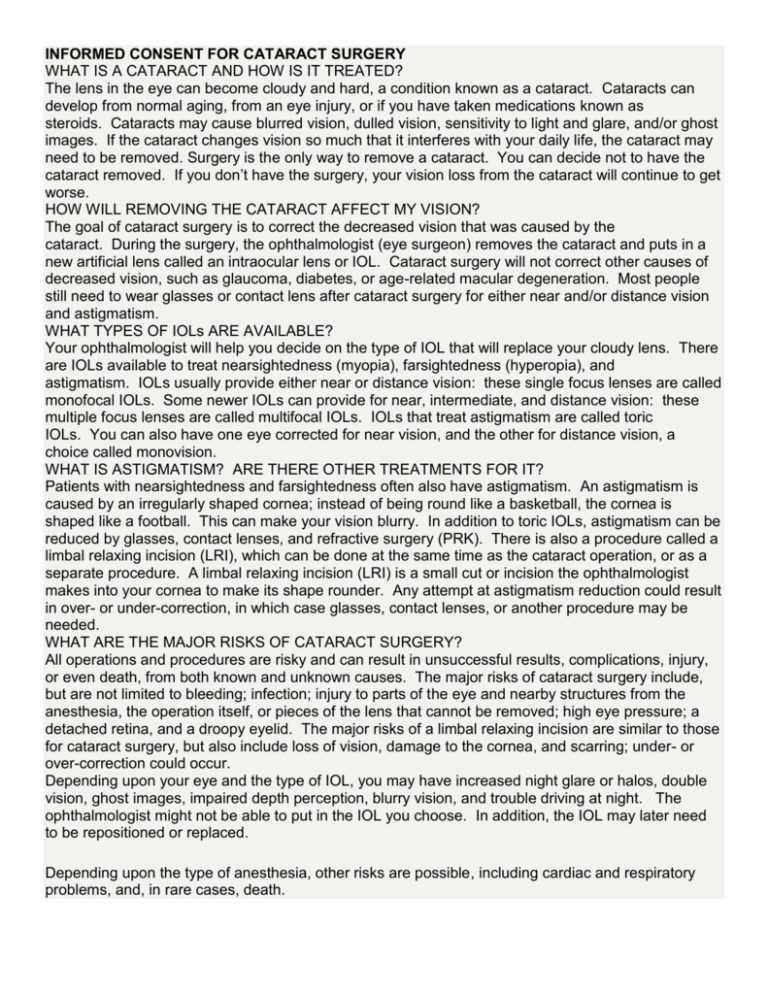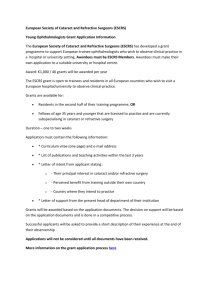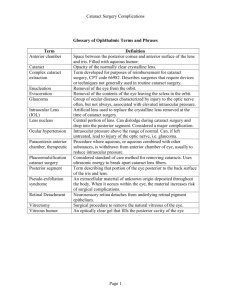INFORMED CONSENT FOR CATARACT SURGERY
advertisement

INFORMED CONSENT FOR CATARACT SURGERY WHAT IS A CATARACT AND HOW IS IT TREATED? The lens in the eye can become cloudy and hard, a condition known as a cataract. Cataracts can develop from normal aging, from an eye injury, or if you have taken medications known as steroids. Cataracts may cause blurred vision, dulled vision, sensitivity to light and glare, and/or ghost images. If the cataract changes vision so much that it interferes with your daily life, the cataract may need to be removed. Surgery is the only way to remove a cataract. You can decide not to have the cataract removed. If you don’t have the surgery, your vision loss from the cataract will continue to get worse. HOW WILL REMOVING THE CATARACT AFFECT MY VISION? The goal of cataract surgery is to correct the decreased vision that was caused by the cataract. During the surgery, the ophthalmologist (eye surgeon) removes the cataract and puts in a new artificial lens called an intraocular lens or IOL. Cataract surgery will not correct other causes of decreased vision, such as glaucoma, diabetes, or age-related macular degeneration. Most people still need to wear glasses or contact lens after cataract surgery for either near and/or distance vision and astigmatism. WHAT TYPES OF IOLs ARE AVAILABLE? Your ophthalmologist will help you decide on the type of IOL that will replace your cloudy lens. There are IOLs available to treat nearsightedness (myopia), farsightedness (hyperopia), and astigmatism. IOLs usually provide either near or distance vision: these single focus lenses are called monofocal IOLs. Some newer IOLs can provide for near, intermediate, and distance vision: these multiple focus lenses are called multifocal IOLs. IOLs that treat astigmatism are called toric IOLs. You can also have one eye corrected for near vision, and the other for distance vision, a choice called monovision. WHAT IS ASTIGMATISM? ARE THERE OTHER TREATMENTS FOR IT? Patients with nearsightedness and farsightedness often also have astigmatism. An astigmatism is caused by an irregularly shaped cornea; instead of being round like a basketball, the cornea is shaped like a football. This can make your vision blurry. In addition to toric IOLs, astigmatism can be reduced by glasses, contact lenses, and refractive surgery (PRK). There is also a procedure called a limbal relaxing incision (LRI), which can be done at the same time as the cataract operation, or as a separate procedure. A limbal relaxing incision (LRI) is a small cut or incision the ophthalmologist makes into your cornea to make its shape rounder. Any attempt at astigmatism reduction could result in over- or under-correction, in which case glasses, contact lenses, or another procedure may be needed. WHAT ARE THE MAJOR RISKS OF CATARACT SURGERY? All operations and procedures are risky and can result in unsuccessful results, complications, injury, or even death, from both known and unknown causes. The major risks of cataract surgery include, but are not limited to bleeding; infection; injury to parts of the eye and nearby structures from the anesthesia, the operation itself, or pieces of the lens that cannot be removed; high eye pressure; a detached retina, and a droopy eyelid. The major risks of a limbal relaxing incision are similar to those for cataract surgery, but also include loss of vision, damage to the cornea, and scarring; under- or over-correction could occur. Depending upon your eye and the type of IOL, you may have increased night glare or halos, double vision, ghost images, impaired depth perception, blurry vision, and trouble driving at night. The ophthalmologist might not be able to put in the IOL you choose. In addition, the IOL may later need to be repositioned or replaced. Depending upon the type of anesthesia, other risks are possible, including cardiac and respiratory problems, and, in rare cases, death. There is no guarantee that cataract surgery or astigmatism reduction will improve your vision. As a result of the surgery and/or anesthesia, it is possible that your vision could be made worse. In some cases, complications may occur weeks, months or even years later. These and other complications may result in poor vision, total loss of vision, or even loss of the eye in rare situations. You may need additional treatment or surgery to treat these complications. This additional treatment is not included in the fee for this procedure. PATIENT’S ACCEPTANCE OF RISKS I understand that it is impossible for the doctor to inform me of every possible complication that may occur. By signing below, I agree that my doctor has answered all of my questions, that I have been offered a copy of this consent form, and that I understand and accept the risks, benefits, and alternatives of cataract surgery. I have checked my choice for astigmatism correction and type of IOL. __________Monofocal IOL/Glasses Option I wish to have a cataract operation with a monofocal IOL on my _______________ (state “right” or “left” eye) and wear glasses for _____________________ (state “near” or “distance”) vision. __________Monovision with 2 IOLs Option (may still need glasses) I wish to have a cataract operation with two different-powered IOLs implanted to achieve monovision. I wish to have my ______________ (state “right” or “left”) eye corrected for distance vision. I wish to have my ___________ (state “right” or “left”) eye corrected for near vision. __________Multifocal IOL Option (may still need glasses) I wish to have a cataract operation with a _____________________ multifocal IOL implant (state name of implant) on my _______________ (state “right” or “left”) eye. __________Toric monofocal IOL/Glasses Option for Astigmatism Reduction I wish to have a cataract operation with a toric monofocal IOL on my _______________ (state “right” or “left” eye) and wear glasses for _____________ (state “near” or “distance”) vision. __________Limbal Relaxing Incision for Astigmatism Reduction (may still need glasses) I wish to have this procedure done in addition to the cataract operation. Patient (or person authorized to sign for patient) ________________________________________ Date:___________________






